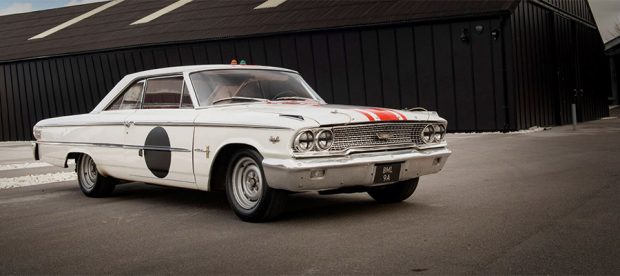
For years, the British Touring Car Championship (BTCC) was dominated by Jaguars. From the legendary Mk1 and Mk2 saloons to Stirling Moss’s victory in a Mk7 at the 1952 Daily Express International Trophy meeting, a Jaguar was the clear choice if you wanted to win a race outright when the series began in 1958. But that all changed on May 11th, 1963. When Jack Sears arrived at Silverstone with a Ford Galaxie, an American buil V8 machine from the world of NASCAR, it signalled the start of an era where American V8 power was the norm at the front of the field for over a decade.
The Galaxie quickly proved itself to be a formidable force. Despite the presence of renowned drivers Graham Hill and Roy Salvadori, Sears blew past the leading Jaguars on Hangar Straight when he hit 135mph and disappeared out of sight. He went on to win the 12-lap race by an incredible 20 seconds, setting a new lap record and even outrunning the brand-new 1100cc Mini Cooper S driven by John Whitmore.
At the end of May, a non-championship race at Aintree cemented the Galaxie’s dominance, with Sears again taking first place. Finally, at Crystal Palace, the next round of the BTCC, Sears and Gawaine Baillie’s Galaxie cruised past Salvadoi and Hill once again, proving that it wasn’t just fast and at home on a straight but could also take on more twisty, technical tracks.
Naturally, the Galaxie didn’t come without its fair share of controversy. Questions were raised about the legality of the American build, which resulted in alterations that weakened the car’s roll-cage and had to be reverted back to drum brakes after the Royal Automobile Club refused to let them run discs on the front. But even with these changes, the Ford still came out on top.
Sears took first place again at Snetterton in a non-championship bout and followed this up with another 1-2 finish alongside Baillie at Silverstone in the Grand Prix support race. Jim Clark eventually ended Sears’ winning streak at Brands Hatch in August, but even then it was a Galaxie, run by Alan Brown.
It was clear that the Americans had changed the game forever. Autosport remarked at the end of the season that nothing could keep up with the two cars and looked forward to the “splendid spectacle” that the American muscle cars provided.
60 years later and the American muscle cars continue to shape the BTCC, and in many ways, motorsport as a whole. The Ford Galaxie ushered in a new era of V8 domination, and set the wheels in motion for a new level of racing excitement. From its very first race, the American muscle car had proven itself capable of challenging the best and leaving its mark on the BTCC for generations to come.
The immediate success of the Ford Galaxie sparked a wave of enthusiasm for American muscle cars in the BTCC, with other iconic vehicles such as the Dodge Charger, Plymouth Barracuda and Chevrolet Camaro quickly becoming staples of the series. These cars provided a unique challenge to the touring car drivers of the time, incorporating aspects of stock car racing with the demands of a traditional road course. This new style of racing emerged as a precursor to the regulations used today in a range of racing categories, which blend traditional touring car elements with those of sports car and stock car formats.
Alongside their performance on the track, the American muscle cars also became legendary for their showmanship. The powerful V8s produce an unmistakable roar and the engines had to be frequently replaced due to the intense heat they generated. Carrying a wide array of liveries, the American muscle cars also drew in large crowds of enthusiasts who would watch them thunder around the circuit.
The impact of the American muscle car on the BTCC can still be seen to this day. As the series has grown, so too has the technology and regulations allowing for more powerful machines capable of handling the diverse circuits the championship visits. With the current regulations allowing for larger displacement engines, the American muscle car legacy is more relevant than ever.
From the Mustang Mach 1 of 1969 to the Dodge Charger and various Raysees and Chevrolets, American muscle cars continued to remain an influence on the BTCC throughout the following decade. These cars were consistently quick just like the Galaxie and allowed drivers to display their own individual style.
By the late 1970s, the American muscle cars had been supplanted by more modern cars. But that doesn’t mean their legacy was forgotten. The presence of these cars in the BTCC continues to inspire future generations of racers and the fact that they’ve risen to fame in the world of motorsport remains a testament to their enduring impact.
Even today, the American muscle car remains a popular choice for fans of the series and drivers alike. Drivers such as Matt Neal, Tom Chilton and Tom Oliphant have found success and fame with their American-built machines, bringing the spirit of the original Galaxie back to BTCC.
The legacy of the American muscle car in British Touring Car Racing can’t be overstated. From its introduction in 1963 until now, the cars have left their mark on the series and paved the way for further innovation in motorsport. With each new generation of cars, the influence of the American muscle car shows no sign of fading, and as long as BTCC continues to race, we’ll be sure to see some American muscle cars out on the track.
VN:F [1.9.22_1171]
VN:F [1.9.22_1171]
Source link


